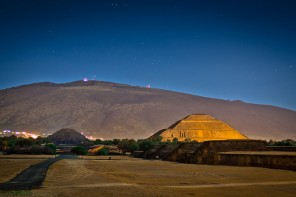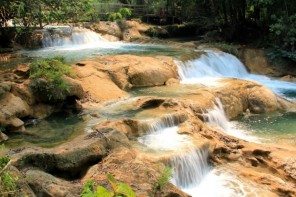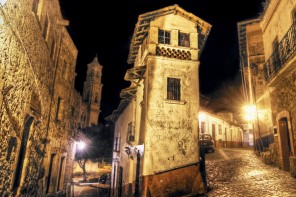Palenque is a quaint, little town and a great gateway into the Maya World. It offers nice, affordable accommodations and different options for a tasty breakfast or dinner. The town is just a few minutes from the archeological site that bears the same name, one of the most astounding Maya cities preserved throughout the centuries, thanks to the lush jungle. Palenque is close to some other important attractions such as the Agua Azul (Blue Water), Agua Clara (Clear Water) and Misol-Ha Cascades.
Information:
Palenque is a ruin city that is part of the Maya civilization that dates back to 100 BC to its fall around 800 BC. It is located on the western edge of the Maya empire near the present-day city of Chiapas, Mexico. The ruins left behind are very well preserved and maintained by local people as well as anthropologists. Currently, it is one of the most popular ruins for tourists from around the world to visit.
Palenque is located at about 9000 feet above sea level overlooking the lower coastal plain stretching to the Gulf of Mexico about 80 miles to the north. The ruins can be found throughout a thick forest of mahogany, cedar and sapodilla trees, which in turn has kept the ruins hidden for many years until it was discovered by the Spaniards in the mid to late eighteenth century. In early morning hours the ruins are often covered in a blanket of fog. The fog, combined with the sun and trees produces one of the most aesthetically grand ruins ever visited. The site of Palenque stays at an average temperature of 79 degrees Fahrenheit and remains humid with an average precipitation per year of 85 inches of rain.
The Ancient Maya people that lived in Palenque had a refined system of writing. They had an extensive written language which was both phonetic and ideographic. Mayan words were written in hieroglyphs with each picture having its own meaning. Unlike other ancient central American civilizations, the Maya could write in words, sentences, and even stories. Arranging several pictures together in a logical form would create a story. The Maya covered their cities and buildings with hieroglyphs carved into stone. Most of the Maya could read some hieroglyphs, but the priests and nobles were the only people who actually had knowledge of the entire language. They would use quills made of turkey feathers to write in books made of soft bark taken from a type of fig tree.
Religion was the center of the Maya life. The Maya believed that there were two levels of the world, the first level was the physical world and the second was the spiritual world consisting of dead ancestors, gods, and other supernatural creatures. The Maya kings and spiritual leaders would tell the lower levels of the society what would please the Gods. The Gods were modeled after animals for sacrificial purposes and religious ceremonies. They had an understanding of astronomy, engineering, and mathematics. The Maya priests studied their measurement of time that consisted of a calendar with 18 months, each containing 20 days, plus 5 unlucky days that made up the Maya year. They also had a religious calendar that had 260 days to which they gave a name and a number. They believed that each day was a God that carried the weight of the day on its back.
The Maya civilization in all stages has been based on agriculture. Indian corn or maize was domesticated from a wild grass in central Mexico about 7,000 years ago and it provided most of the food at that time. It is well known that the Maya enjoyed chocolate and they consumed it in many forms from a frothy drink to a pulpy mush. The Maya referred to chocolate as “The Drink of the Gods”. They had other food such as cornmeal, black beans, roasted meat, rabbit stew, turkey and other meats. Many people also chewed the leaves of the sapodilla tree as a gum-like substance.
The culture of the Maya was rich in the arts including dance, music, and brightly colored clothing. They had more than 5,000 dances and they loved music. Dancing was a huge part of religious ceremonies where musicians played wooden flutes and trumpets made of wood, seashells, or clay, and drums made from turtle shells. For clothing, the men would have worn a loincloth and the women would wear loose sack-like dresses. The cloths of the nobles and priests were made of finer materials and had many shells and beads on them. For ceremonies they would wear beautiful headdresses. They practiced body deformation such as tying boards to the forehead of newborn children. Also, some had filed their teeth down to a point and then placed jade into the holes.
Although the sight of Palenque originated at about 100 BC, it did not become a major population with importance in the Maya culture until 600 AD. At this time their greatest ruler, Pacal, assumed power. Pacal took power in 603 AD and ruled for 68 years. During his rule, he emphasized the construction grand buildings to reflect his power. One of his great structures was the Palace. The Palace was made with mansard-type roofs and the walls were covered with priceless stucco carvings of rulers, gods, and ceremonies that have taken place. On the inside of the palace were a plethora of rooms with interior courts that overlooked a four-story square tower that may have served as both lookout and observatory for the people of that time. Underneath the palace and through a long, corbel-vaulted tunnel, a stream ran through carrying a constant supply of running water. Flowing water through a monumental structure like that was a feat of engineering genius. Some say the Palace may not have been lived in because of the cold dampness of the rooms and no sign of people living there.
Another structure Pacal had built would end up being his eternal resting place, the Pyramid of Inscriptions. In this Pyramid he was buried at the age of 80 year old upon the end of his 68-year reign. The importance of this burial site is that it is the most extraordinary feature of Palenque with a tomb that held the sarcophagus of Pacal, an unusually tall ruler. Within this sarcophagus was the richest offering of jade ever seen in a Maya tomb. Placed over his face, a mask fitted with jade mosaic and a suit of priceless jade adorned his body. Each piece of hand- carved jade was threaded together with gold wire.
The Maya were an incredible civilization and nobody knows exactly why the empire fell. Some people believe it was from disease, famine, or civil war. Someday we may know more of the secrets of Palenque because archeological excavations are ongoing at the site. With time, hopefully all the mysteries of Palenque will be revealed.
Resources
“Virtual Palenque” (3/21/01)
“Palenque Project” (3/22/01)
“Palenque” (3/22/01)
“Mayan” (3/23/01)
Written by: Michael Schrom





